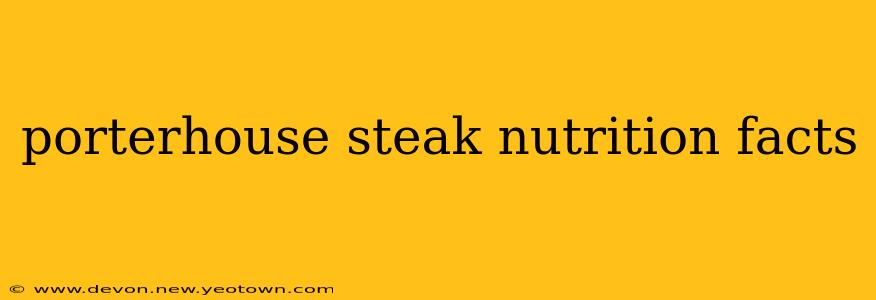The aroma of a sizzling porterhouse steak, its rich juices glistening under the heat—it's a culinary experience that tantalizes the senses. But beyond its decadent flavor lies a nutritional profile worth understanding. This isn't just a delicious indulgence; it's a significant source of several essential nutrients. Let's delve into the world of porterhouse steak nutrition, uncovering its benefits and potential drawbacks.
What are the Nutritional Benefits of Porterhouse Steak?
A porterhouse steak, prized for its large tenderloin and sirloin portions, packs a nutritional punch. It's a powerhouse of protein, providing the building blocks for muscles, tissues, and enzymes. This high-protein content contributes to satiety, helping you feel fuller for longer and potentially aiding in weight management. It’s also a good source of iron, crucial for oxygen transport throughout the body, and zinc, vital for immune function and wound healing. Furthermore, porterhouse steak offers B vitamins, including niacin and vitamin B12, essential for energy production and nerve function. These nutrients work synergistically to support overall health and well-being.
How Many Calories are in a Porterhouse Steak?
The calorie count of a porterhouse steak varies significantly depending on its size and preparation method. A 3-ounce serving can range from approximately 200 to 300 calories. However, larger cuts naturally contain more calories. Adding butter, oil, or rich sauces during cooking can dramatically increase the calorie content. Understanding portion size and cooking methods is key to managing your calorie intake.
Is Porterhouse Steak High in Fat?
Yes, porterhouse steak is relatively high in fat compared to leaner cuts of beef. Much of this fat is saturated fat, which should be consumed in moderation as part of a balanced diet. However, the fat also contributes to the steak's rich flavor and tenderness. The type of fat also matters. The marbling, those beautiful streaks of fat within the meat, adds to the flavor and juiciness and contains conjugated linoleic acid (CLA), which has been linked to various health benefits, though more research is needed. Moderation is key; choosing leaner cuts or trimming excess fat before cooking can help manage fat intake.
What are the Potential Downsides of Eating Porterhouse Steak?
While porterhouse steak offers many benefits, it's important to be mindful of potential drawbacks. Its high saturated fat content contributes to higher cholesterol levels in some individuals. Those with heart conditions or high cholesterol should consume it in moderation. The high sodium content, often added during processing or through marinades, can also be a concern for individuals monitoring their sodium intake. Finally, the cooking method can impact the nutritional value; overcooking can reduce nutrient content and increase the formation of harmful compounds.
Is Porterhouse Steak Good for Weight Loss?
The suitability of porterhouse steak for weight loss depends on the individual's overall diet and exercise routine. Its high protein content promotes satiety, which can aid in weight management. However, the high calorie and fat content require careful portion control. Incorporating it into a balanced diet with plenty of fruits, vegetables, and whole grains, while maintaining an active lifestyle, can allow for its inclusion in a weight-loss plan, but it shouldn't be the cornerstone.
How Can I Prepare a Healthy Porterhouse Steak?
Preparing a healthy porterhouse steak involves making smart choices. Trimming excess visible fat before cooking reduces the calorie and fat content. Opting for grilling, broiling, or baking over frying minimizes added fats and oils. Seasoning with herbs and spices instead of heavy sauces enhances flavor without adding extra calories or sodium. Finally, mindful portion control is crucial for reaping the benefits without overindulging.
In conclusion, the porterhouse steak, a culinary delight, offers a rich nutritional profile with notable benefits. However, mindful consumption, considering portion sizes, cooking methods, and overall dietary balance, is essential to fully enjoy its pleasures while minimizing potential drawbacks. This nutritional powerhouse, when enjoyed responsibly, can be a delicious addition to a healthy lifestyle.

